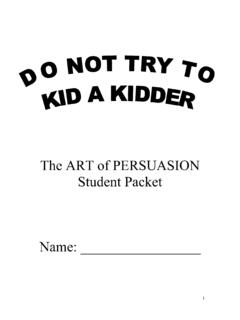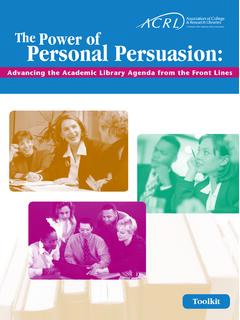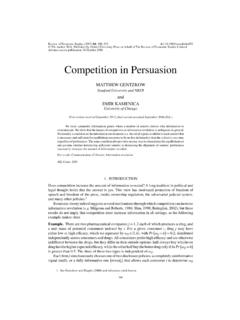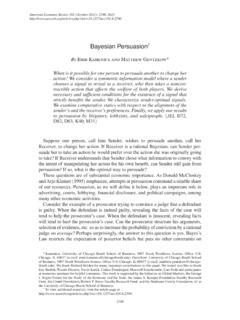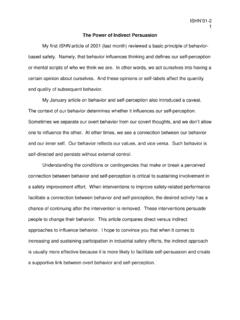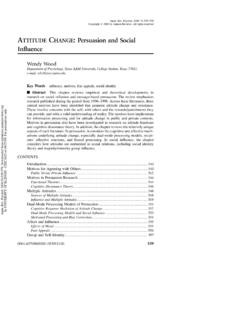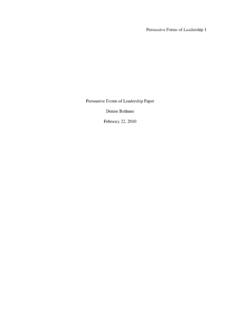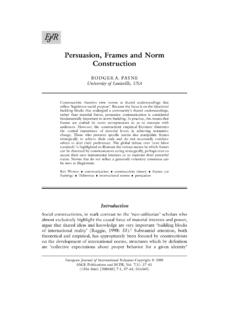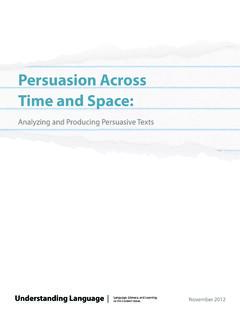Transcription of Persuasion - World Bank
1 Persuasion | CommGAP PersuasionDefining PersuasionPersuasive communication is any message that is intended to shape, reinforce, or change the responses of another or Such responses are modified by symbolic transactions (messages) which are some-times, but not always, linked with coercive force (indirectly coercive) and which appeal to the reason and emotions of the target. Generally, Persuasion refers to such communicative activities that are mediated. Those that are face-to-face are called Persuasive communication can be targeted at Cognition. Persuasion can be used to change individuals beliefs about an object or an issue, which includes attributes, interpretation, definition, outcome, etc. Attitude. Persuasion can be used to change individuals attitude toward an object or an issue, which refers to the categorization of an object or an issue along an evaluative dimension (from negative to positive).
2 Behavior. Persuasion can be used to change individuals behavior, which is the overt actions regard-ing an object or an vs. PropagandaPropaganda is the communication of a point of view with the ultimate goal of having the recipient come to voluntarily accept the position as if it were his or her In addition to the pejorative flavor, propa-ganda has some essential and distinctive features:4 Propaganda has a strong ideological bent. Propaganda is institutional in involves mass tends to rely on ethically suspect methods of vs. ManipulationThere are elements of manipulation and coercion implied in Persuasion . However, Persuasion is ethically neutral. It is the motives of the persuader that determine if a given persuasive attempt is good or bad.
3 Persuasion also serves a defensive, anti-manipulation function. 1 Miller, G. R. (1980). On being persuaded: Some basic distinctions. In M. Roloff, & G. R. Miller (Eds.), Persuasion : New directions in theory and research, 11 28. Beverly Hills, CA: Sage. 2 Wilson, S. (2002). Seeking and resisting compliance: Why people say what they do when trying to influence others. Thousand Oaks, CA: Sage. 3 Pratkanis, A. & Aronson, E. (1991). Age of propaganda: The everyday use and abuse of Persuasion . New York: W. H. Freedman & Company. 4 Gass, R. & Seiter, J. (2006). Persuasion , social influence, and compliance gaining, 3rd ed. Boston, MA: | CommGAP | 2 Individuals free will and free choice are intact in Persuasion . They are able to make informed deci- sions as to if they comply with the persuasive messages or is symbolic, which is generally more ethical than influence via nonverbal or behavioral of PersuasionSourCe CreDibilityThe impact of source credibility on Persuasion can date way back to ancient Greece (ethos).
4 Social scien-tific research in Persuasion showed that there are two major dimensions in source credibility: expertise and trustworthiness, although dynamism, liking, similarity and physical attractiveness might also influence source ,6 Information and Source Credibility:A means to enhance expertise: Information on background, formal training, education, personal expe- rience, and knowledge on the means to enhance trustworthiness: legitimacy, speaking against one s own interest, endorsement. Non-Verbal Communication and Source Credibility:7 Features that enhance expertise: fluency, facial pleasantness/smiling, facial expressiveness. Features that enhances trustworthiness: facial pleasantness/smiling, facial expressiveness.
5 Message Delivery and Source Credibility:7 Features that enhance credibility: pitch variation, citation of sources Features that diminish credibility: filled pauses, response latency Maximizing the Impact of Source Credibility on Persuasion :Personal relevance minimizes the impact of source credibility Positioning of the source at the beginning maximizes impact rAtionAl AnD eMotionAl APPeAlSAttitude is based upon, or generated from, three general classes of information: cognitive, affective, and (past) Research is rapidly accumulating empirical evidence that Persuasion is the result of both cognitive and affective ,10 Hence, there are two general means to Persuasion : rational 5 Berlo, D. K., Lemert, J. B., & Mertz, R. J.
6 (1969). Dimensions for evaluating the acceptability of message source. Public Opinion Quar-terly, 33, 563 576. 6 McCroskey, J. C. & Teven, J. (1999). Goodwill: A re-examination of the construct and its measurement. Communication Monographs, 66, 90 103. 7 Burgoon, J., Birk, T. & Pfau, M. (1990). Nonverbal behaviors, Persuasion , and credibility. Human Communication Research, 17, 140 169. 8 Zanna, M. P. & Rempel, J. K. (1988). Attitude: A new look at an old concept. In D. Bar-Tal & A. W. Kruglanski (Eds.), The social psy-chology of knowledge, 315 334. Cambridge, UK: Cambridge University Press. 9 Nabi, R. (2002). Anger, fear, uncertainty, and attitudes, a test of the cognitive-functional model. Communication Monographs, 69, 204 216.
7 10 Stephenson, M. T. (2003). Examining adolescents responses to antimarijuana PSAs. Human Communication Research, 29, 243 | CommGAP | 3appeal and emotional appeal. A rational appeal uses logical arguments and factual evidence to persuade individuals that the advocacy is viable and likely to result in the obtainment of goals. An emotional appeal is designed to arouse emotions among the recipient and use the emotions as bases for Persuasion . Persuasion via rational appeal: the cognitive response tradition of Persuasion posits that the persuasive effectiveness of a message is a function of the individual s cognitive responses to the ,12,13 If the overall cognitive response is positive, there will be Persuasion ; otherwise, the persuasive attempt fails or even boomerangs.
8 Generally speaking, the success of a rational appeal thus depends on the strength and quality of arguments in the message, given that the recipient is able and motivated to process the message. Factual evidence can be in the form of statistics or personal testimonies. There is no evidence showing the advantage of one over the other. 14 If either ability or motivation to process the message is low, recipients are less likely to scrutinize message arguments, but tend to be influenced by non-content features of message, for example, message modality, chan-nel, source credibility, etc. Persuasion via emotional appeal: The most widely applied emotional appeal in Persuasion is fear appeal. The term is sometimes interchangeable with the term threat appeal when the emphasis is on the informational content of the message, rather than the arousal it activates among the recipients.
9 Meta-analyses have demonstrated strong evidence for the effectiveness of fear ,16 there is also evidence that guilt appeal is Fear appeal: A typical fear appeal message has two components: the threat component and the recommendation component. The threat component should present the risk information: the severity of the risk and the individual s susceptibility to this particular risk. The recommendation component presents the recommended behavior to cope with the risk: the response efficacy, which refers to the effectiveness of the recommendation in removing the threat, and self-efficacy, which refers to the individual s capability to enact the recommended behavior. Guilt appeal: A typical guilt appeal message has two components: One presents materials to evoke guilt through drawing attention to some existing inconsistencies between the recipients standards and actions, the other describes the recommended behavior or viewpoint, which is meant to offer the prospect of guilt reduction.
10 ReSiStAnCe to Persuasion Psychological reactance: When individuals perceive the messages as a restriction on their freedom to hold a particular attitude or to engage in certain behavior, they might experience psychological reactance and reject the ,19 Message features that could lead to reactance include: inten-tion to persuade, illegitimacy, and language intensity. 11 Albarracin, D., McNatt, P., Ho, R., Klein, C., Mitchell, A., & Kumkale, G. (2003). Persuasive communication to change actions: An analysis of behavioral and cognitive impact in HIV prevention. Health Psychology, 22, 166 177. 12 Eagle, A. H., & Chaiken. S. (1993). The psychology of attitudes. New York: Harcourt Brace Jovanovich. 13 Petty, R. E., Ostrom, T.










